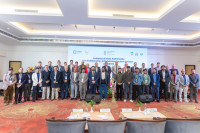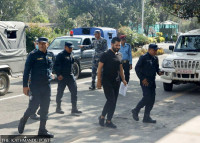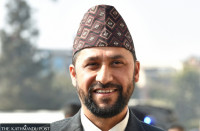National
Less than one in a thousand have received housing grants so far
Only 700 of 770,000 families have got first installment of Rs 200,000
Bhadra Sharma
Even as Nepal observes the first anniversary of the Gorkha Earthquake, less than one-tenth of a percent of the affected households have received cash grant for building houses.
Out of 770,000 families rendered homeless, only 700 have received first installment of the Rs 200,000 cash grant for building houses and it was released only a few weeks ago, in an indication how sluggish the approach has been on the part of the National Reconstruction Authority when it comes to reaching out to the needy.
Firstly, the NRA spent months to conduct detailed assessment of houses and infrastructure destroyed by the quake.
So far, the Central Bureau of Statistics has listed 710,000 households as quake affected in 11 districts. The survey is yet to be completed in some VDCs in these districts and is yet to start in three districts of Kathmandu Valley—Kathmandu, Bhaktapur and Lalitpur. According to details provided by the Ministry of Home Affairs, during preliminary data collection 80,093 houses were found to have been destroyed in Kathmandu Valley. Out of them, 43,587 houses were destroyed in Kathmandu, 17,601 in Lalitpur and 18,905 were destroyed in Bhaktapur. Additionally, 73,608 houses were partially damaged.
While the housing grant has just started to reach the victims, a huge amount of money has already been spent for assessment purpose, something NRA officials admit themselves. The exact amount is yet to be calculated.
“Huge resource has been mobilised for the assessment but we are yet to get exact details of the expenditure,” said NRA Spokesperson Ram Prasad Thapaliya. Critics say repeated assessments were nothing but waste of time and resources, which have only complicated the post-earthquake reconstruction.
“Such survey must be conducted immediately after things return to normalcy. We missed that opportunity,” said Bhojraj Pokharel, former home secretary. “This has not only complicated the reconstruction process but also has raised questions about the credibility of the process.”
When the government had collected details immediately after the earthquake by mobilising local authorities in the districts, the number of earthquake affected household was estimated to be around half a million. The number rose to 770,000 when the government announced winter relief package after distributing immediate cash relief.
The NRA started detailed damage assessment in January again based on the agreement with the donors.
“But there was no need for the NRA to wait for all data to arrive for starting reconstruction work. Grant distribution and survey could have been carried out simultaneously,” said Govind Raj Pokhrel, former vice-chairman of the National Planning Commission, who for a while was at the helm of the NRA. “I don’t doubt their [NRA’s] intention, but innovation and pragmatism was lacking.”
He said the delay in developing integrated settlement and socio-economic integration programmes in the quake-affected districts could push the reconstruction work towards a complete failure.
“For instance, I had called the concerned stakeholders to conduct internal settlement risk assessment in the third week of August. It has not been done,” he added.
Since some quake-hit households have already started rebuilding houses on their own, stakeholders are worried about the prospects of building back better.
Over 31,000 households have already rebuilt their houses in 11 districts, according to preliminary CBS data. Most of the houses have been built in Gorkha, followed by Sindhupalchok, where the number of people (3,532 persons) killed in the earthquake was highest. Over 300 out of 1,400 quake-destroyed homes have already been reconstructed in Barpak, of Gorkha, the epicentre of the April 25 earthquake, according Gorkha CDO Narayan Prasad Bhatta.




 18.12°C Kathmandu
18.12°C Kathmandu















